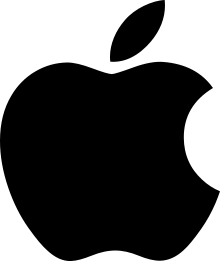Apple Campus
The Apple Campus is the former corporate headquarters of Apple Inc. from 1993 until 2017, when it was largely replaced by Apple Park, though it is still used by Apple as office and lab space. The campus is located at 1 Infinite Loop in Cupertino, California, United States. Its design resembles that of a university, with the buildings arranged around green spaces, similar to a suburban business park.
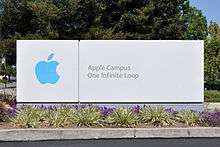 Entrance sign on Infinite Loop | |
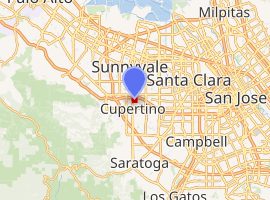
| |
| Built | 1993 |
|---|---|
| Location | Cupertino, California, U.S. |
| Coordinates | 37.33182°N 122.03118°W |
| Architect | Sobrato Development Company |
| Area | 850,000 square feet (79,000 m2) |
| Address | 1 Infinite Loop Cupertino, CA 95014 |
History and founding
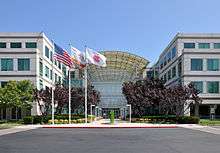
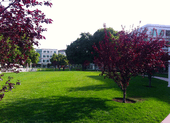
Apple's corporate headquarters was originally located at Building 1 on 20525 Mariani Ave in Cupertino. The land east of Mariani One across De Anza Boulevard where the campus was built was originally occupied by the company Four-Phase Systems (later acquired by Motorola). It has an area of 850,000 square feet (79,000 m2). Construction began in 1992 and was completed in 1993 by the Sobrato Development Company.[1] Before 1997, activities held on the campus were exclusively research and development. Until that time the buildings were referred to as R&D 1-6. With the return of Steve Jobs to Apple in 1997, changes were made to the campus: Apple increased the number of occupied buildings, and many activities not related to R&D were moved to the buildings on Infinite Loop, at which point they began to be referenced by their IL # designations. Steve Jobs left additional marks on the campus, for example, banning employees' pets[2] and dramatically improving the cafeteria menu.
On the night of August 12, 2008, a fire broke out on the second floor of the building Valley Green 6. The firefighters worked for hours until the following morning to extinguish the fire. No injuries were reported, but the forty-year-old building suffered $2 million of fire damage.[3]
Location and layout
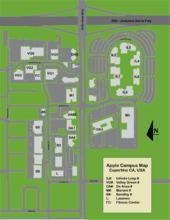
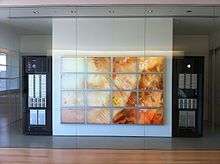
The Apple Campus is located on the southeast corner of Interstate 280 and De Anza Boulevard, and occupies 32 acres (130,000 m2)[4] in six buildings spread over four floors. Each building is numbered with one digit on the private U-shaped street Infinite Loop, so named because of the programming concept of an infinite loop. The street, in conjunction with Mariani Avenue, actually does form a circuit (or cycle) that can circulate indefinitely. The main building has the address 1 Infinite Loop, Cupertino, California. Employees refer to these buildings as IL1 to IL6 for Infinite Loop 1-6. Besides the buildings on Infinite Loop, the whole Apple Campus occupies an additional thirty buildings scattered throughout the city to accommodate its employees. Some of these buildings are leased (with an average rental cost of $2.50 per square foot),[5] while others are of recent acquisition; the land that the new buildings occupy will be used for future construction of a second campus in the city with the aim of centralizing the activities of the company. In total, including nine newly acquired buildings on Pruneridge Avenue, the company controls more than 3,300,000 square feet (310,000 m2) for its activities in the city of Cupertino. This represents almost 40% of the 8,800,000 square feet (820,000 m2) of office space and facilities for research and development available in the city. At 1 Infinite Loop is an Apple Store selling Apple equipment and souvenirs. It is the only part of the campus open to the public.[6]
Apple Park
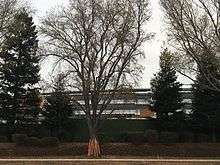
In April 2006, Steve Jobs announced to the city council of Cupertino that Apple had acquired nine contiguous properties to build a second campus, termed Apple Campus 2,[7] located one mile east of the existing facility. Apple has had a presence in Cupertino since 1977, which is why the company decided to build in the area rather than move to a cheaper, distant location. Purchases of the needed properties were made through the company Hines Interests,[8][9] which in at least some cases did not disclose the fact that Apple was the ultimate buyer;[9] Philip Mahoney, a partner with a local commercial real estate brokerage, noted that this is common practice in attempts to arrange the purchase of contiguous land made up of multiple parcels with separate owners, in order to keep costs from skyrocketing and not reveal the company's plans to competitors.[9] Among the sellers of the properties were SummerHill Homes (a plot of 8 acres (32,000 m2)) and Hewlett-Packard (three buildings of their campus in Cupertino).[9]
On June 7, 2011, Apple's then-CEO Steve Jobs presented to Cupertino City Council details of the architectural design of the new buildings and their environs. The new campus, on a site totalling 176 acres (0.71 km2), includes housing for up to 13,000 employees in one four-storied circular building of approximately 2,800,000 square feet (260,000 m2), a café for 3,000 sitting people, and is surrounded by extensive landscaping. Other facilities include a 1,000 seat auditorium, 300,000 square feet (28,000 m2) of R&D facilities, a fitness center, an orchard, and a dedicated generating plant as the primary source of electricity (powered by natural gas and other environmentally sound means).[10] Jobs stated: "It's got a gorgeous courtyard in the middle, and a lot more. It's a circle, so it's curved all the way round. This is not the cheapest way to build something."; this proved to be Jobs' last public appearance before his death in October 2011. Media reports widely described the new structure as a "spaceship".[11] Many compared the structure to "Tulou", a UNESCO World Heritage Sites listed architecture, which has a strikingly distinctive circular shape.[12] El Economista[13] revealed that architect Lord Norman Foster was in charge of the design of the new campus.
The project's ground-breaking ceremony occurred in 2012,[14] but the Cupertino city council only approved the plans on October 15, 2013, after a six-hour debate resulting in unanimous agreement.[15] Shortly thereafter, demolition work began to prepare the site for the new construction.[16] The campus, now termed Apple Park, opened and largely replaced the Infinite Loop site in April 2017, though Apple has stated that it will keep the old buildings as ancillary office space.[17][18]
References
- "Portfolio - Commercial: Apple Computer World Headquarters". The Sobrato Organization. 2007. Archived from the original on April 2, 2009. Retrieved May 10, 2010.
- "Steve Jobs, Pitbull Lover". Motherboard. October 10, 2011.
- "Fire burns building at Apple headquarters". San Francisco, CA: KGO-TV/DT. August 13, 2008. Archived from the original on March 14, 2010. Retrieved July 19, 2010.
- "PiperJaffray addresses 22 unanswered Apple questions". AppleInsider. May 4, 2006. Retrieved May 10, 2010.
- Simonson, Sharon (September 30, 2005). "Apple gobbles up Cupertino office space". San Jose Business Journal. Retrieved May 11, 2010.
- Bell, Karissa. "Inside Apple's redesigned campus store in Cupertino". Mashable. Retrieved November 22, 2015.
- "News : Apple Campus 2 Project Update". Cupertino. Retrieved May 28, 2013.
- Simonson, Sharon (April 21, 2006). "Apple teams with Texas firm on new Cupertino campus". San Jose Business Journal. Retrieved May 10, 2010.
- Chandler, Michele (April 28, 2006). "How Apple found 50 acres in Cupertino and why they paid big bucks for it". San Jose Mercury-News. Archived from the original on June 28, 2006. Retrieved September 27, 2014.
- "Steve Jobs Presents to Cupertino City Council". cupertino.org.
- "Apple's 'Spaceship' Campus Budget Reportedly Balloons To $5B, Will Look To Cut $1B Before Proceeding". TechCrunch. April 4, 2013. Retrieved May 28, 2013.
- https://www.everyday.com.kh/mobile/en/article/48324.html
- elEconomista.es. "Norman Foster trabaja en el diseño de la nueva 'Ciudad de Apple' en Cupertino - elEconomista.es". eleconomista.es.
- Fry, Stephen (May 26, 2015). "When Stephen Fry met Jony Ive the self-confessed tech geek talks to Apple's newly promoted chief design officer". The Telegraph. Archived from the original on May 31, 2015. Retrieved May 31, 2015.
- May, Patrick (October 15, 2013). "Cupertino council clears huge Apple 'spaceship' campus for liftoff". San Jose Mercury News. Retrieved October 16, 2013.
- Clover, Juli (December 5, 2013). "Demolition at New Apple Campus 2 Well Underway". MacRumors.
- Cunningham, Andrew (February 23, 2017). "Apple's new spaceship campus gets a name, lifts off in April". Ars Technica.
- Press Release (February 22, 2017). "Apple Park opens to employees in April". Apple Inc. Archived from the original on February 24, 2017. Retrieved February 24, 2017.
External links
| Wikimedia Commons has media related to Original Apple Campus. |
